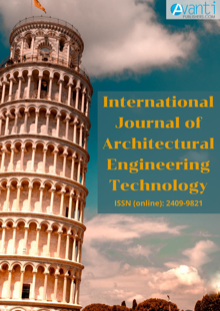Abstract
Wind-driven natural cross ventilation to many single-aspect apartments can be achieved via building indentations and façade articulation. The ventilation rate of these apartments will rely on pressures differences between openings caused by approaching wind pressure, local wind climate and interaction with the surrounding built environment and external pressure gradients on the building indentations or any other facades articulation and their potential driving force on natural ventilation. Detailed simulation methods are therefore required to consider all above mentioned parameters and provide internal and external airflow information to the design team to allow for design modifications or refinement where required to provide robust natural cross ventilation for such apartments. This study assesses the above parameters for a proposed development, designed with recesses and slots to enhance natural cross ventilation in single-sided apartments, and presents a reliable procedure to advise on compliance with national and/or international design guidelines utilising an advanced combined outdoor-indoor Computational Fluid Flow (CFD) analysis integrated with localized weather data for the project site.References
Swami M, Chandra S. Correlations for Pressure Distribution of Buildings and Calculation of Natural-Ventilation Airflow, ASHRAE Transactions, 1988; 94: 244-266.
Pana W, Liu S, Lia S, et al. A Model for Calculating Singlesided Natural Ventilation Rate in an Urban Residential Apartment, Building and Environment, 2019; 147: 372-381. https://doi.org/10.1016/j.buildenv.2018.08.047
Asfour O, Gadim M. A comparison between CFD and Network models for predicting wind-driven ventilation in buildings, Building and Environment, 2007; 42(12): 4079- 4085. https://doi.org/10.1016/j.buildenv.2006.11.021
Zhang R, Lam K, Yao S, Zhange Y. Coupled EnergyPlus and computational fluid dynamics simulation for natural ventilation Building and Environment, 2013; 68(12): 110-113. https://doi.org/10.1016/j.buildenv.2013.04.002
Mohamed M, King S, Behnia M, Prasad M. A study of singlesided ventilation and provision of balconies in the context of high-rise residential buildings, World Renewable Energy Congress, Linkoping, Sweden, 2011. https://doi.org/10.3384/ecp110571954
BS Code of Practice for Ventilation Principles and Designing for Natural Ventilation, 1991.
Marzban S, Ding L, Fiorito F. An Evolutionary Approach to Single-sided Ventilated Façade Design, Procedia Engineering, 2017; 180: 582-590. https://doi.org/10.1016/j.proeng.2017.04.217
Etheridge D, Nolan J. Ventilation Measurements at Model Scale in a Turbulent Flow, Building and Environment, 1979; 14: 53-64. https://doi.org/10.1016/0360-1323(79)90029-5
Katoa S, Murakamia S, Mochida A, Akabayashi S. VelocityPressure of Cross Ventilation with Open Windows Analyzed by Wind Tunnel and Numerical Simulation, Journal of Wind Engineering and Industrial Aerodynamics, 1992; 2575-2586. https://doi.org/10.1016/0167-6105(92)90049-G
Van Hooff T, Blocken B. Coupled Urban Wind Flow and Indoor Natural Ventilation Modelling on a High-Resolution Grid: A case study for the Amsterdam Arena stadium. Environmental Modelling & Software, 2010; 25: 51-65. https://doi.org/10.1016/j.envsoft.2009.07.008
Al-Khalidy N. Designing Better Building with Computational Fluid Dynamics Analysis, 4th International Congress on Computational Engineering and Sciences, Las Vegas, University of Nevada, (Reno, USA), 2012.
NSW Department of Planning, Industry and Environment, Apartment Design Guide, https://www.planning.nsw.gov.au/apartmentdesignguide, June 2015.
AS1668.2-2002, The Use of Ventilation and Airconditioning in Buildings Part 2: Ventilation Design for Indoor Air Contaminant Control (excluding Requirements for the Health Aspects of Tobacco Smoke Exposure).
Ansys Fluent Theory Manual, 2019.

This work is licensed under a Creative Commons Attribution-NonCommercial 4.0 International License.
Copyright (c) 2020 International Journal of Architectural Engineering Technology




